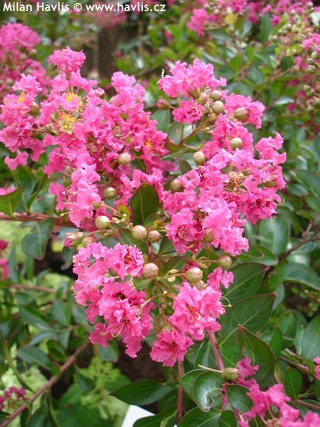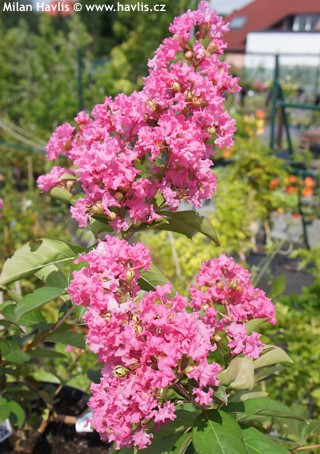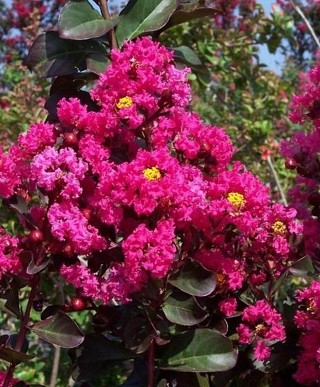Lagerstroemia 'MARDI GRAS' crape myrtle
size/type
medium-sized shrub,medium-sized shrub
usual height
0,5-1m
usual width
0,5-1m
leaves
deciduous broadleaf
colour of leaves
flowers
showy
colour of flowers
blooming time
July-September
location
full sun
USDA zone (lowest)
8 (down to -18°C)
winter protection
for zone 5+6

for zone 7

categorized
Lagerstroemia
Crape myrtle is a flowering shrub or small tree from China. It was first introduced to the USA and the UK in the 18th century. The original plant lagerstroemia indica is too tender and not too pretty so breeders were working on further hybridization and the most attractive varieties available now are believed to be results of crossing with l.speciosa and l.fauriei. Far more important news for us is the fact that among those finished plants were selected others that survived lower temperatures than what was common in the areas of natural habitat so we have a few myrtles that can grow even in our climate. Some were selections, other further hybrids.Description of the plant:
Mardi Gras is a miniature crape myrtle. It bears rich panicles of violet to pink flowers from mid summer until frost. The upright branches tend to weep with age making an oval-weeping appearance. Deciduous leaves are ovate to oval, bright green and glossy.Leaves of lagerstroemias change to various shades of yellow, orange and red in autumn. When they fall down older plants reveal flaking-off bark, similar to what plane trees or stewartias do, leaving a mosaic pattern on the smooth trunks.
Crape myrtle needs little care. They need full sun with zero shade during the day. Pruning will secure flowering: cut back last year's growth to about a third of its original size. Do so in spring after danger of frosts. The plant will make strong news shoots that will bear flowers. Grow in well-drained soil that should be kept moist before it gets fully established. Some sources say that plants do well in slightly acidic soil but as far as it is not water-logged they will grow in any fertile soil. It needs heavy mulching in winter and some mulch in summer to retain moisture. Overfertilizing will cause excessive growth but no flowers. Guaranteed hardiness is -18°C (USDA zone 7) but is supposed to survive a few more degrees downwards.
Last update: 29-12-2009
QUICK PRICE OVERVIEW
CURRENTLY SOLD OUT
WANT TO TRY A SIMILAR PLANT?

















